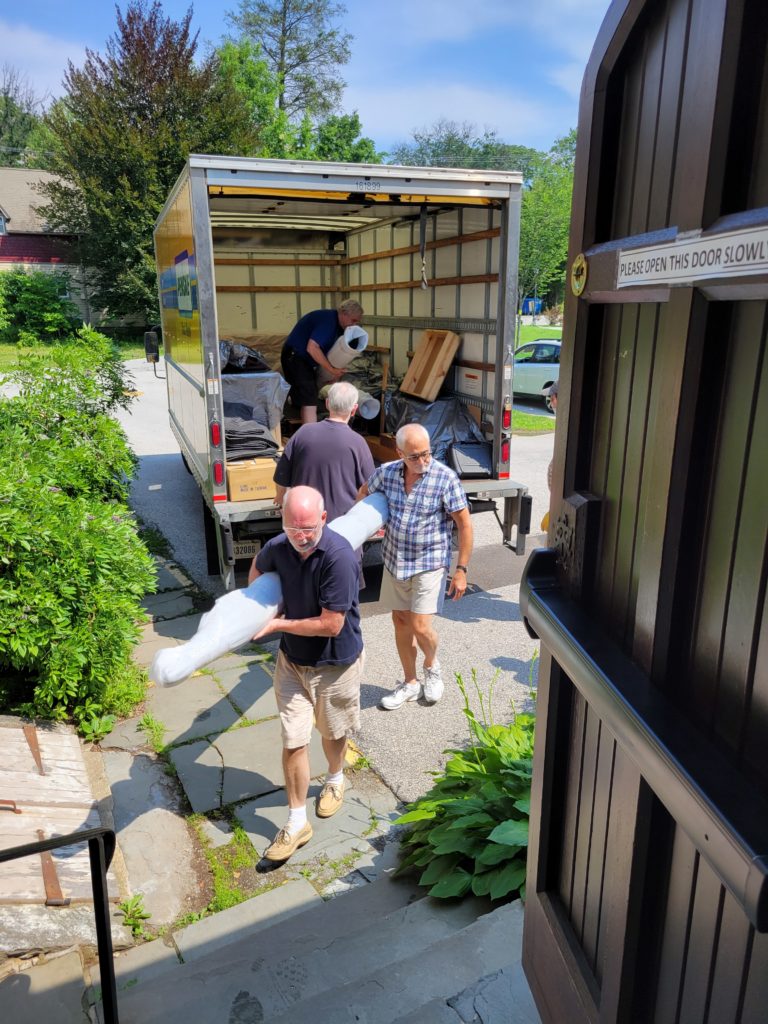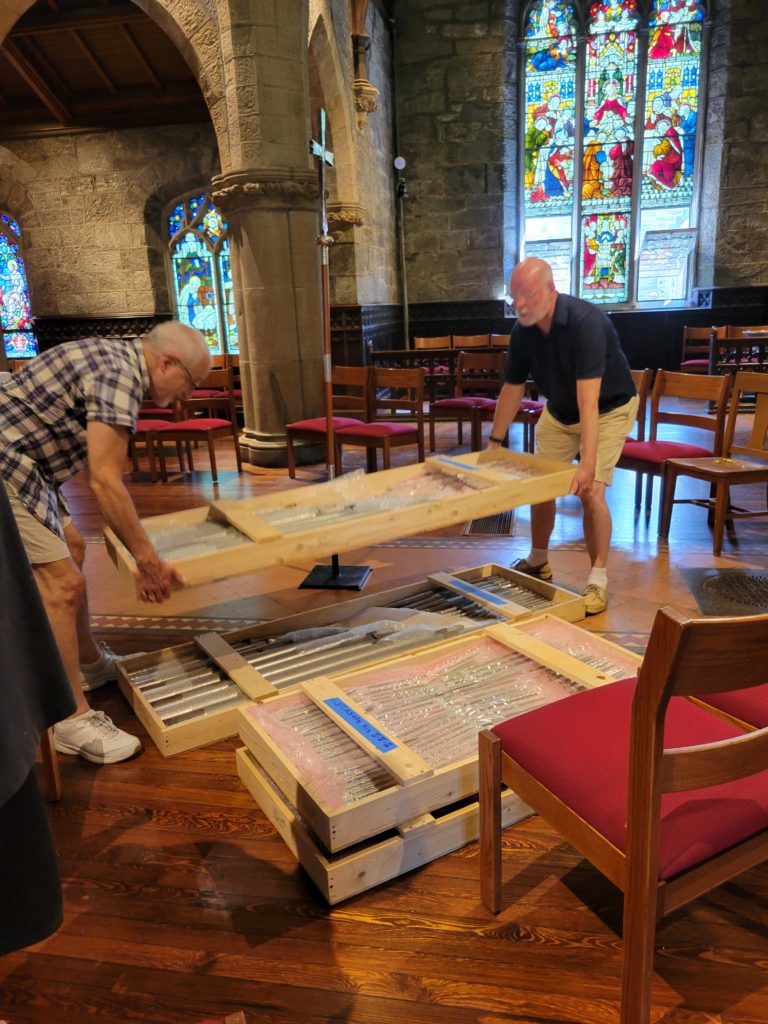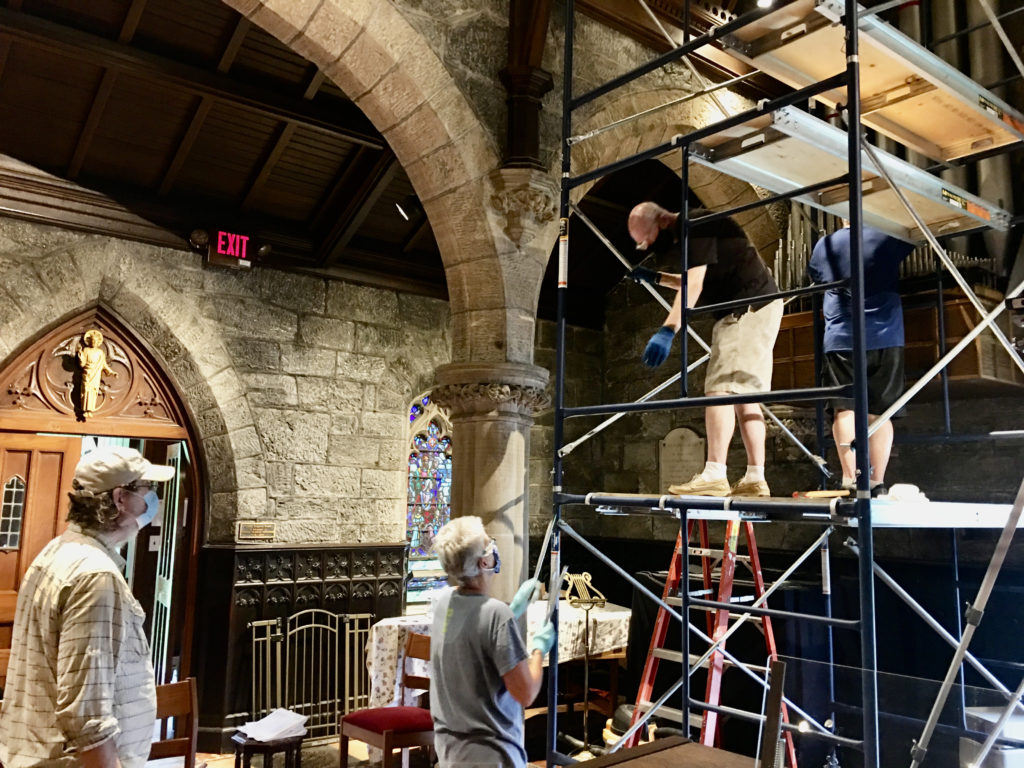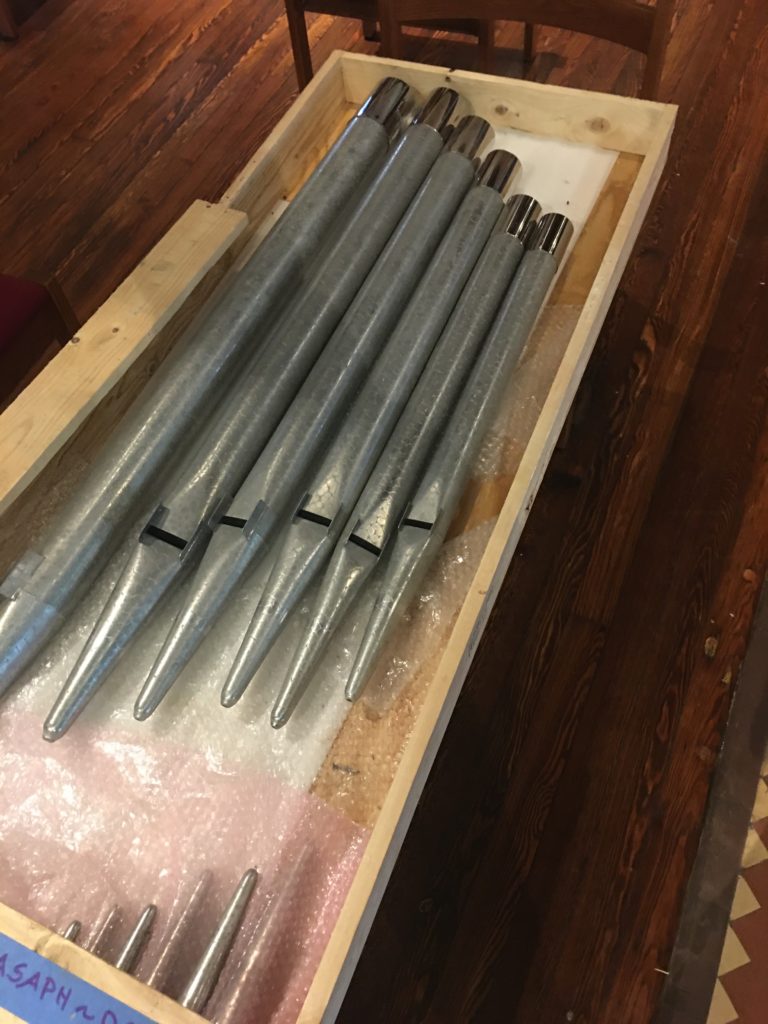A New Organ at The Church of Saint Asaph
I am so pleased and honored to be able to announce the beginning of a new and significant project in the life of St. Asaph’s – a new organ! Plans twelve years in the making are becoming a reality after the arrival of two significant bequests, one from Jack Moore, a longtime choir member and music supporter. Jack sang in the choir from the age of 6 and retired (as an alto!) at age 65. Thereafter he was best known to many as our ever-reliable crucifer. A second bequest from Elizabeth Lee Oliver, a former congregant who recently remembered us in her will, provided the balance needed to begin the project. After reviewing two proposals from two different organ builders, the Vestry agreed to sign a contract with Johannus Orgelbau, a Dutch company represented locally by Cunningham Piano and Organ Company of King of Prussia, PA, and Chuck Nelsen, for a two-manual 45-stop Monarke custom-built organ.
This new proposed digital-pipe hybrid organ would consist of a much smaller console more in scale with the size of the sanctuary. The majority of the stops (stops produce the sounds like an oboe, or a flute, as well as more traditional organ sounds) in this digital instrument will be recorded samples of actual pipes from around the world, the digital portions of the instrument essentially forming a “virtual” organ. The list of stops will be reduced to a more appropriate scale while still retaining the full organ impact that the current instrument provides. New technology provides for a much smaller speaker system that will be mounted in the ceiling of the church nave eliminating all visible wiring and restoring floor space currently used by speakers and wires at the rear and the front of the church. The wind-blown pipes at the rear of the church would be reactivated, along with the blower mounted in the northwest corner of the church and be made part of the component of stops on the console. This marriage of a classic pipe organ with state-of-the-art digital sampling technology will create an instrument of exceptional beauty and versatility.
The new organ console will be easily moved about the sanctuary in keeping with the flexible chair system we currently have, and new technologies will offer more flexibility in console placement, requiring only a single USB-sized jack in the floor at four different “stations” of the church. A central remote processor and amplifier system, located in the basement, would provide the needed amplification and interface mechanisms for the windblown pipes and reduce the overall weight of the console. Speakers installed in a 1998 expansion of the instrument (located above the windblown pipes) would also be reactivated.
The resulting instrument would place St. Asaph’s squarely at the forefront of modern church organ design and technology in the Philadelphia region. It will be the first new instrument of its sort in the Philadelphia area and will be featured broadly in local organ guilds’ recital programs and other musical events. Hybrid virtual organs are becoming the new normal, and this instrument will be known especially for its unique qualities and international pedigree. The Johannus Company is extremely excited with the prospect of this contract, installing and maintaining what they describe as a “landmark instrument” in the United States. I too am extremely excited to see what will become part of the legacy of my 30-plus year dedication to the music program at St. Asaph’s.
I will be traveling to Amsterdam in mid-July to meet with the technicians, carpenters, and tonal designers of Johannus Orgelbau to set our parameters for voicing, stop lists, console layout and finishes, that will begin the design phase of this project. We are currently estimating that we will dedicate the completed instrument around Easter of 2020. Installation of speakers will begin during the Summer months and will be connected to the existing instrument until the new instrument arrives.
The old Austin three-manual console, at the front of the church, has some resale value as a result of Peterson electronics that were installed around 1998. The pipework in the basement associated with the instrument has little resale value, although I am working with several organ clearing houses to find a suitable new home. The current Johannus digital instrument also has some resale value attached to it. I believe, between the three components we could realize a portion of our initial investment.
UPDATE: A Vist to The Netherlands
I am writing this update from somewhere over the Atlantic Ocean on our way back from Ede, Netherlands. Chuck Nelsen and I are returning from our three-day trip to the Johannus factory to meet with the cabinet makers, tonal designers, technicians, and accountants for the manufacture of the new organ for St. Asaph’s. In our tour of the factory we saw instruments being built for other installations destined for the Philippines, Ireland, France, Salt Lake City and Korea. We then drove through the Netherlands countryside touring other installations in churches in Ede, Utrecht, and Echt. Each was a remarkable instrument, but one stood out in particular: that of the ThomasKirche in Echt. It was molded in the French Romantic style, of which we were basing our own concept for the St. Asaph’s organ, in a centuries-old Roman Catholic church. It was a wonderful experience for me to play works by Vierne, Hindemith, Franck, and others, on this instrument in a sanctuary with about 3 seconds of reverb!
The next day in the factory we began the process with the console design. I brought a piece of molding from St. Asaph’s for the cabinet makers to match in wood and stain color. We laid out the other woods to be used including those for the wooden keyboards (they will be made with oak naturals and maple sharps), the console shell (to match the wood sample), the stop jams (made of lighter-colored oak) and the bench (two-toned with the dark wood and the lighter oak.) The overall two-manual design is more modern than traditional in layout, low profile, and designed with flexibility and portability in mind (the console is meant to be moved about the church to accommodate different seating arrangement.) Lighted “rocker tabs,” as they are called, will be on either side of the keyboards, laid out with the Swell and Pedal stops on the left and the Great stops and couplers on the right. There will be fifty stops in total! We also designed the number and location of the toe studs, expression shoes, and the layout of combination buttons on the keyboard rails (the “rail” is the area underneath the keyboard) all in keeping with AGO (American Guild of Organists) specifications. Other components for the operation of the instrument were also laid out, including the memory/menu screen, Zimbelstern (a German baroque instrument composed of 6 small bells that are rung in sequence to accompany some traditional Baroque music) and other technical features.
After a short lunch break, we began the hard work of listening to the 4,500 pipe samples in Johannus’ library from organs around the world. From this library I would select the 50 that would ultimately comprise our own instrument. Using the Echt organ as a basis, the remaining component of stops were added, listening carefully and playing each new sample for such things as blend, color, warmth of sound, and compatibility with the rest of the instrument. All of this had to be accomplished with my own memory of the sound of the existing pipework, currently on our instrument back in Bala Cynwyd, so as to blend seamlessly. The new instrument at St. Asaph’s will have digital samples of instruments by Cavaile coll (French), Silbermann (German), E.M. Skinner (American), and D. Harrison (Brittish). All of it will be brought to crescendo by a Trompette en chamade, a large-scaled “horizontal trumpet” that will have its own set of speakers at the front of the church. The names engraved on the stop tabs will be in French in keeping with the overall French romantic approach to the instrument. This effort took most of the day, and the patience of the staff of Johannus is to be commended!
Day three was involved mainly with review and design and placement of the audio systems, working out budget constraints and delivery schedules, and finally, a traditional Dutch lunch of Poffertjes in Laren on our way back to the airport.
What was created in those three days will no doubt result in one of the finest and most flexible musical instruments in the Philadelphia area. It’s warm sound and colorful disposition will be able to recreate music from many, many, eras, and accompany and encourage our weekly songs of praise for many years to come. It should also serve the community well being put to use in organists’ guild recitals, chamber ensembles, and other musical programs.
A special thanks goes out to Chuck Nelsen, of Cunningham Piano and Organ in King of Prussia, and all of those involved in Holland: Vincent van Os (Project Manager), Rene van de Hoef (General Sales Manager), and Bertus (Technician extradonaire!). Their dedication to the craft of organbuilding was inspiring. And their heartfelt hospitality, seemingly an innate Dutch quality, left an indelible impression.


UPDATE: Work continues on Schedule
Construction of our new instrument continues as we approach several milestones. Pipes from the old Austin organ in the chancel have been removed and placed in a secure area of the basement. You’ll note from the photos here that the pipes are all in good shape, despite their age, and the hope for finding them a new home continues. Thanks to Father, Barry, Steve Sheeran, and Diana Post who all helped in their safe removal.
Some of the newly manufactured speakers for the digital portion of the new instrument have arrived from Amsterdam (by way of Chicago!) and currently reside in the chancel area awaiting installation. Wiring for the new speakers is scheduled to begin November 4, with scaffolding going up at the rear of the church. Before wiring work can proceed, all of the pipes at the rear of the church (the Antiphonal Division of the Austin Pipe Organ) will be removed to allow access for those working on the wiring. These pipes will be taken to a workshop in Ohio to be cleaned, polished, and refurbished for use. This Antiphonal Division will form the foundation of the new Great Division of the organ and will speak publicly for the first time in over a decade upon the completion of the new instrument. The blower for the pipes, tucked away in the Northwestern corner of the ceiling (I’ll bet you never noticed this) will also be cleaned and reconditioned.
Shop drawings for the custom-designed console have been finalized. The cabinet will be handmade from quarter-sawn oak at a small cabinet maker in Ede, Netherlands. (I visited this shop on my visit to Holland and met the man who oversees the cabinet making, a Dutch craftsman who takes great pride in his work.) As you can see from the image below, it is a significant departure from traditional organ design, very low in profile yet in full compliance with all American Guild of Organists specifications. It will also have a full-size roll-top cover to protect it from dust when not in use. I took a sample of the woodwork from St. Asaph’s with me on my trip so the woodworker will be able to match the stain color in the sanctuary.


It is expected that the new console will arrive somewhere around March of 2020. Installation, tuning, and voicing will take approximately another month. We are hoping to be able to debut the new instrument for Easter of 2020!
In the meantime, please be aware of the disruption to our worship space and format that will result from this project. We may not have access to an organ to lead our services at some point. And scaffolding and construction debris may have an impact on how we conduct our weekly worship services. I ask for your patience – the reward is well within sight!
As mentioned above, the former Antiphonal Division of Austin pipes will be refurbished for use in the new organ as the foundation of the new Great Division. The pipes are being shipped to Ohio for cleaning, polishing, and refurbishing. We are planning on their return, repositioning, and tuning in time for Easter of 2020. Here are some photos of that portion of the project.



On Friday, November 8, Electricians from Stahl Electric finished the wiring for the new console ports (4), new power supply, and the new speaker system in the ceiling of the church. Additional speakers are installed in the ceiling of the chancel area for what will become the new Trumpet En Chamade. In all, 24 speaker cabinets with three speakers each, were installed.


In another phase of the project, we said goodbye to the Austin Console in the chancel area of the church on Tuesday, December 10. The console, installed in 1964, served the parish well for almost 45 years! The console has been moved to storage while we look for another suitable home for it. Here are photos of the moving process.


Just under the wire from forced restrictions, the new organ console was delivered to St. Asaph’s on Friday, March 20. In order to expedite the delivery in time for Easter, the Dutch company Johannus shipped it by airplane to PHL rather the original shipping plan by boat to Chicago then freight truck to Bala Cynwyd. As it is now in the US, this exceptional effort to get the organ ready in time for Easter was unfortunately for naught since the installation of the instrument is now on hold due to CoVID-19. Some work may continue on installation of processors and amplifiers in the basement, thanks to Chuck Nelsen who will be working solo. The delivery of the newly cleaned pipes, originally scheduled for March 27, will probably be postponed to a later date.
The new console is a beauty! I’ve attached a picture below of the console in its new home along with some of the delivery personnel involved.




The console arrived the day before government restrictions went into place in the light of Coronavirus protection. The church was shut down, along with the school, for a period of several months during what was labeled the “red” phase of coronavirus reopening program in Montgomery County. Church services were held remotely via Zoom and only the Rector was allowed in the building. The organ console remained in the building unattended, and the pipework remained in Ohio, where it had been sent for cleaning and re-voicing. Once we reached the “yellow” phase, work began on connecting the instrument to the audio system, but services continued virtually. The “green” phase for reopening came about in mid-June, but there were still many restrictions in place for gathering communities in number. We began “broadcasting” from the church, using the digital portion of the organ, but Zoom technology limits the broad expression of the instrument and virtual recordings provide for a less-than-perfect rendering of the new organ’s capabilities.
In July, Cunningham Piano and Organ interview Roy Harker, the Director of Music and the Arts, showcasing the yet-unfinished instrument. It is available on YouTube and will hopefully have another chapter once the pipework is installed. You can view the video below:
Saturday, June 19, 2021: The organ pipes arrive!
After a year-long Covid-related delay, the new organ project at St. Asaph’s in back on track with the delivery of our refurbished organ pipes for the Great division. Approximately 425 pipes, ranging in size from 6” inches to 8’ in length, have been cleaned, given new tuners, and shined up for display. Some of the larger pipes shown here are “wrapped like mummies” for the trip from Ohio. A crew of volunteers from the church unloaded the truck and placed the pipes in the transept until wiring is completed. The crew consisted of Roy Harker, Bob Ranando, Ed Lawler, Chuck Nelsen, Steve Sheeran, Fred Wolfe, and Peter Van der Spek.
The entire instrument will be finished, tonally, by a representative from the factory in Holland on a visit here to the States in August, and will be featured in the American Guild of Organists 2021-2022 Recital Series beginning in October.






On September 20, 2021, a group of volunteers gathered to place the newly refurbished pipes on the chest. Over the course of two days they were able to place each of the 450 pipes, one by one, on the chests. Thanks to Ron Roggenburk, Steve Sheeran, Susan Christie, Elizabeth Milroy, Diana Post, Bob Ranando, Peter van der Spek, Chuck Nelsen, and Roy Harker. Photos by Ron Roggenburk.


